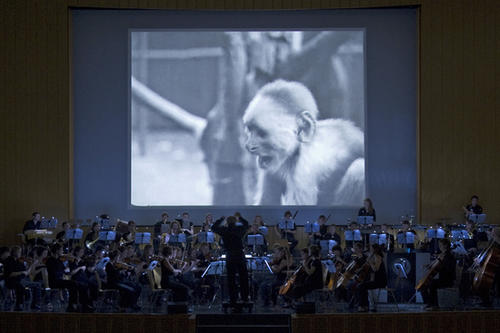When the Violins Fell Silent
Researcher at Freie Universität studies the transition between silent film and sound film
Apr 27, 2011
Lights off, sound on. During the “Long Night of Science” at Freie Universität, the Collegium Musicum symphony orchestra accompanied a silent movie.
Image Credit: Bernd Wannenmacher
Going to the movies just isn’t complete without sound, and that connection between images and sound was an important one even during the earliest days of film as a medium. In the Department of Music Studies at Freie Universität Berlin, researchers led by Professor Albrecht Riethmüller are studying the history of film music in Germany as part of the German Film Music Project.
Peter Moormann is currently dedicating his studies primarily to the film music of the 1920s and 1930s, along with the transition between silent film and sound film. Much of the spectrum of audio effects the 21st-century moviegoer knows from Hollywood was invented back then. Unlike today’s multiplex theaters, where Dolby surround sound systems immerse viewers in music and sounds from all sides, music in the early days of film still represented a lot of handicraft.
Even the world’s very first film presentation, a showing by the Lumière brothers in Paris in 1895, was accompanied on the piano. And at the Ufa-Palast, then the largest movie theater in Berlin, boasting more than 2,000 seats, a 75-person orchestra provided musical accompaniment. “When you look at these dimensions, you can understand why the introduction of films with audio met with so much resistance. A lot of orchestral musicians who had been hired to play nothing but film music lost their jobs,” Moormann says.
As early as one year after the 1929 advent of talkies in Germany, more than half of the musicians who had played at movie theaters were left jobless. They fought tooth and nail against the advance of sound film. The new style was criticized from an aesthetic perspective as well, but without much success, since there was a single group that was utterly unmoved by the criticism: viewers. “The public accepted talkies right away, which quickly put an end to the discussion,” Moormann says.
What fascinates him most about the film music of the early age of movies is the intentions behind the use of sound and music, and the gradual establishment of movie listening habits that are still in place today. Another area of focus in his work is standard situations and the ways in which film music depends on genre. “For a love scene in a movie, you immediately have certain kind of music in mind – violins, for instance,” Moormann explains. “Or take a situation involving a departure – there as well, there are certain modules that composers return to time and again. For example, a theme that suggests getting ready, with military music components – drums, a fast tempo, a military orchestra.”
Moormann has been studying the last great film composer of the silent movie era, Gottfried Huppertz, for a long time. Huppertz is known for composing the music for the large-scale productions of Die Nibelungen and Metropolis by Fritz Lang. Moormann spent several weeks at various archives, where he found not only a complete listing of Huppertz’s works, but also unopened letters and other previously unknown sources.
Further Information
- Dr. Peter Moormann, Institute of Theater Studies, Freie Universität Berlin
Tel.: +49 (0)30 838-50370, Email: peter.moormann@fu-berlin.de

